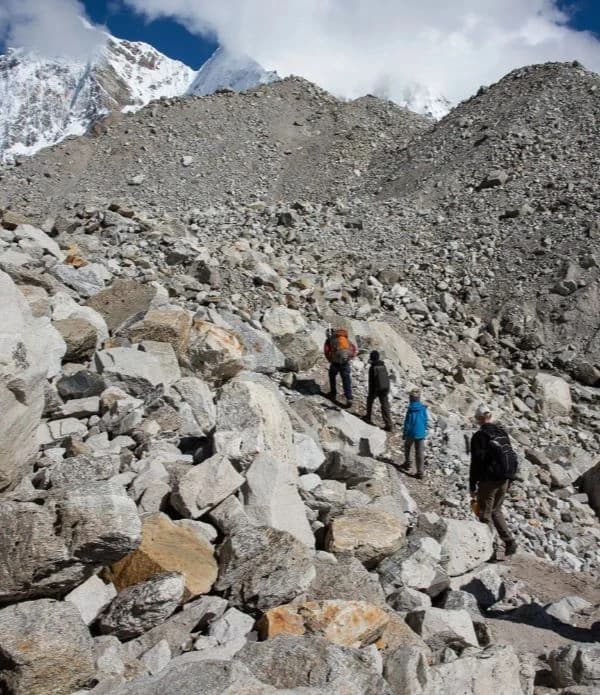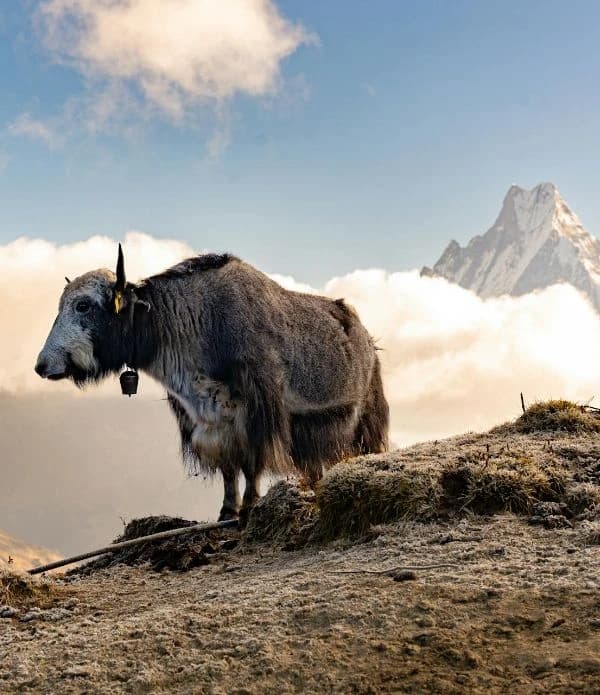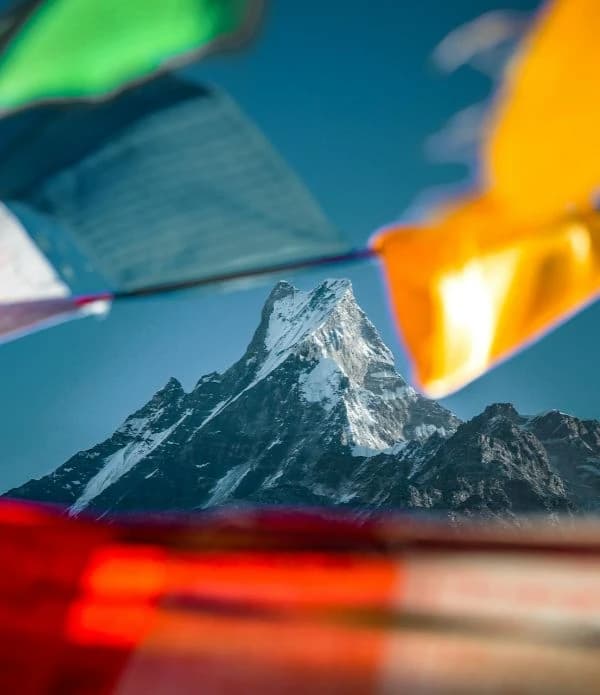The Everest Three Passes Trek is the ultimate test of endurance, covering approximately 160 kilometers (100 miles) from Lukla. This nearly three-week journey isn’t just a trek, it’s an adventure that pushes you to your limits.
How Difficult is the Everest Three Passes Trek?
In the Everest Three High Passes Trek, trekkers cross three formidable high passes—Kongma La (5,535m), Cho La (5,420m), and Renjo La (5,360m)—each presenting its own grueling ascent, unpredictable weather conditions, and extreme altitudes where oxygen levels are significantly lower.
What makes this trek particularly tough is the lack of easy exit points. Once you cross the first pass, there’s no turning back. The terrain is physically exhausting, with long walking hours through rocky moraines, steep inclines, and icy paths, requiring exceptional endurance and mental resilience.
Since the Himalayas are very unpredictable, here are some known factors that make the Everest Three Pass trek even more challenging and difficult.

High Altitude and Acclimatization Challenges
The extreme altitude of the Everest Three-Pass Trek makes it one of the most physically demanding and exhausting treks in the Himalayas. At sea level, oxygen saturation in the air is about 21%, but at altitudes above 5,000 meters, it drops to nearly half, making every step exhausting.
This reduced oxygen affects respiration, stamina, and overall body function, making basic movements feel strenuous and turning the ascents over these passes into a battle against breathlessness and fatigue.
Unlike other treks where altitude gain is gradual, the Everest Three-Pass Trek demands frequent ascents and descents to extreme elevations, often within a short time, increasing the risk of Altitude Mountain Sickness (AMS). Symptoms such as dizziness, nausea, headaches, and breathlessness can strike unexpectedly, making trekkers weak and disoriented.
Without proper acclimatization, AMS can worsen into High Altitude Cerebral Edema (HACE), which affects brain function, or High Altitude Pulmonary Edema (HAPE), a life-threatening fluid buildup in the lungs.
Despite these risks, proper acclimatization can minimize these altitude-related challenges to almost zero, ensuring a safer and more enjoyable trekking experience. The key to adaptation lies in a well-structured itinerary that allows the body to adjust gradually.
Trekking schedules typically incorporate acclimatization days in key locations like Namche Bazaar (3,440m) and Dingboche (4,410m), giving the body enough time to produce more red blood cells to carry oxygen efficiently. The widely followed “climb high, sleep low” strategy ensures trekkers push their bodies to higher elevations during the day and return to lower altitudes for rest, reducing the risk of AMS.
The table below provides a breakdown of the key aspects of Kongma La, Cho La, and Renjo La, highlighting their differences in altitude, difficulty, trail conditions, and more.
|
Aspect
|
Kongma La
|
Cho La
|
Renjo La
|
|
Altitude
|
5,535m (highest)
|
5,420m
|
5,360m (lowest)
|
|
Difficulty
|
Most demanding overall
|
Most technical
|
Most Scenic
|
|
Trail Conditions
|
Rocky and isolated
|
Icy, glacial sections
|
Steep descent
|
|
Weather
|
Windy and snowy
|
Snowy, icy trails
|
Snowy, with steep drops
|
|
Acclimatization Need
|
Extremely high
|
Very high
|
High
|
|
Unique Challenge
|
Long and remote
|
Glacial crossing
|
Steep and narrow trails
|
Length and Duration of the Trek

The Everest Three-Pass Trek is one of the most demanding and rewarding adventures in the Himalayas, taking you through some of the most remote and rugged landscapes in the Everest region. Spanning approximately 20 days, this trek is not for the faint-hearted, requiring 6 to 8 hours of trekking each day, with some of the toughest days pushing even further.
Crossing high-altitude passes like Kongma La (5,535m) and Cho La (5,420m) is particularly grueling, often requiring 10 or more hours of trekking over glacier-covered trails, steep ridges, and exposed, wind-swept terrain. The long trekking hours, combined with the challenges of thin air, make this trek unsuitable for beginners. Even experienced trekkers must prepare for the effects of altitude, which can lead to fatigue, breathlessness, and even altitude sickness, regardless of fitness level.
With long trekking hours, steep elevation gains, and unpredictable high-altitude weather, the Everest Three-Pass Trek is a demanding adventure that pushes your endurance to the limit, making proper physical preparation and acclimatization essential for a successful journey.
Harsh Weather Conditions
As you ascend beyond 5,000 meters, the climate becomes increasingly volatile, with rapid temperature drops, strong winds, and shifting glacial conditions adding to the challenge. The extreme weather is what makes this trek both thrilling and demanding, pushing trekkers beyond their comfort zones while rewarding them with some of the most breathtaking landscapes on Earth.
At such high altitudes, temperatures can plummet well below freezing, even during peak trekking seasons. The mornings and evenings are especially frigid, with icy winds sweeping across the mountain passes. During winter or unexpected snowfalls, the temperature can drop to -20°C or lower, making proper layering and high-quality gear absolutely essential.
At times, winds may stir up loose snow, briefly reducing visibility, but such occurrences are manageable with preparation. The weather in the Himalayas is known for its unpredictability, a clear blue sky in the morning can sometimes give way to afternoon snowfall or passing storms.
Yet, for those who embrace the challenge, this raw and untamed environment is what makes the Everest Three-Pass Trek an unforgettable journey. The thrill of conquering nature’s extremes, standing atop remote mountain passes with panoramic Himalayan views, and pushing your limits in one of the most breathtaking landscapes in the world is an experience like no other.
Challenging Terrain, Technical Sections, and Glacier Crossings

The Everest Three-Pass Trek is not just about breathtaking scenery, it’s an adventure that pushes trekkers beyond their limits with steep ascents, rugged terrain, and thrilling glacier crossings. While the entire trek is physically demanding, certain sections stand out as the ultimate test of skill, endurance, and determination, making the journey both challenging and deeply rewarding.
One of the most technically demanding sections of the trek is the Cho La Pass (5,420m). This pass features a treacherous glacier crossing, where trekkers must carefully navigate through slippery ice fields, hidden crevasses, and steep inclines. During colder months, the path is often covered in ice and snow, requiring crampons and precise footwork. The descent is equally challenging, with large boulders and frozen sections demanding extra caution.
Another grueling yet rewarding challenge is the Kongma La Pass (5,535m), the highest of the three passes. The trail is steep, rocky, and remote, with loose scree adding to the difficulty. Trekkers must endure a long ascent over rugged ridges before reaching the summit, where they are rewarded with panoramic views of Makalu, Lhotse, and Ama Dablam—a breathtaking sight that makes every step worth the effort.
Adding to the challenge is the Ngozumpa Glacier, the largest glacier in Nepal, which must be crossed before reaching Gokyo. This section is surreal yet physically exhausting, as trekkers traverse an unstable trail over loose moraine and ice. Crossing the glacier after 10 PM poses a risk of ice breaking. The ever-changing landscape and thinning ice make each step unpredictable, requiring patience and skill. Depending on the season, deep snow and hidden ice patches can make certain passes even more difficult, increasing the adventure factor.
Physical and Mental Endurance
The Everest Three-Pass Trek is not for beginners, it is a trek designed for seasoned adventurers who are ready to push their physical and mental boundaries. With long hours of trekking each day, steep ascents, and high-altitude conditions, this journey demands a high level of physical fitness. While experienced trekkers may not find the sheer physical challenge of walking for hours a problem, the real test lies in mental endurance.
Trekking for 6 to 8 hours a day over rugged terrain and high-altitude paths is demanding for any trekker, but for those with experience, it's the mental preparation that truly makes a difference. It's not about simply enduring the long hours but about maintaining the right mindset when faced with exhaustion, harsh weather, and physical discomfort.
The mental fortitude to continue on despite fatigue is what separates the casual adventurer from the seasoned trekker on this journey. Experienced trekkers know that the body will tire, but the mind must remain focused.
On this trek, there will be moments of doubt when the steep inclines and demanding passes seem overwhelming. But it is the ability to keep pushing forward, stay positive, and remain determined that makes crossing these high passes feel like an extraordinary achievement.
You will be walking in a place with no facilities, where good food and warm clothes are considered a luxury. The comforts of modern life are far behind, and trekkers will have to prepare themselves mentally and physically to adapt to the rural lifestyle.

Final Thoughts: Is the Everest Three Passes Trek for You?
This journey is for those who seek a true test of their physical and mental strength. The rugged terrain, steep ascents, and glacier crossings will push your limits, but the sense of achievement when you reach the top of each pass is unparalleled.
Not only will you embrace nature's raw beauty, but you will also experience the thrill of walking on some of the most challenging trails on earth, surrounded by towering Himalayan peaks, ancient monasteries, and vibrant Sherpa culture.
To get the most out of the trek and increase your chances of success, prior experience in multi-day and high-altitude trekking is essential. The demanding conditions require physical preparation and the ability to adapt to high elevations. If you are familiar with these challenges, you will be better equipped to tackle the trek and fully enjoy the adventure.
In addition to the physical challenges, this trek offers a refreshing break from the hustle and bustle of daily life, providing an opportunity to disconnect, reflect, and immerse yourself in a new way of life. You will experience life in remote villages, far away from modern conveniences, and connect with local cultures in ways that few travelers get to.
If you're someone who craves adventure, wants to test your limits, and is eager to learn from the world’s most remote regions, the Everest Three-Pass Trek is your perfect fit. It’s more than just a trek, it’s an opportunity to push your boundaries, embrace new experiences, and come away with memories that will last a lifetime.
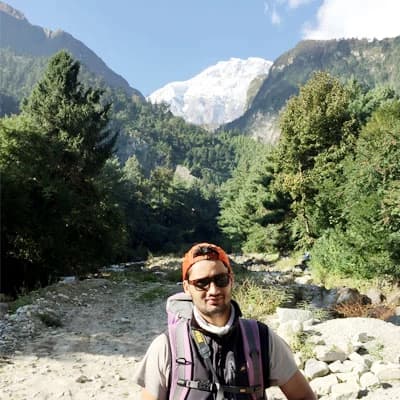
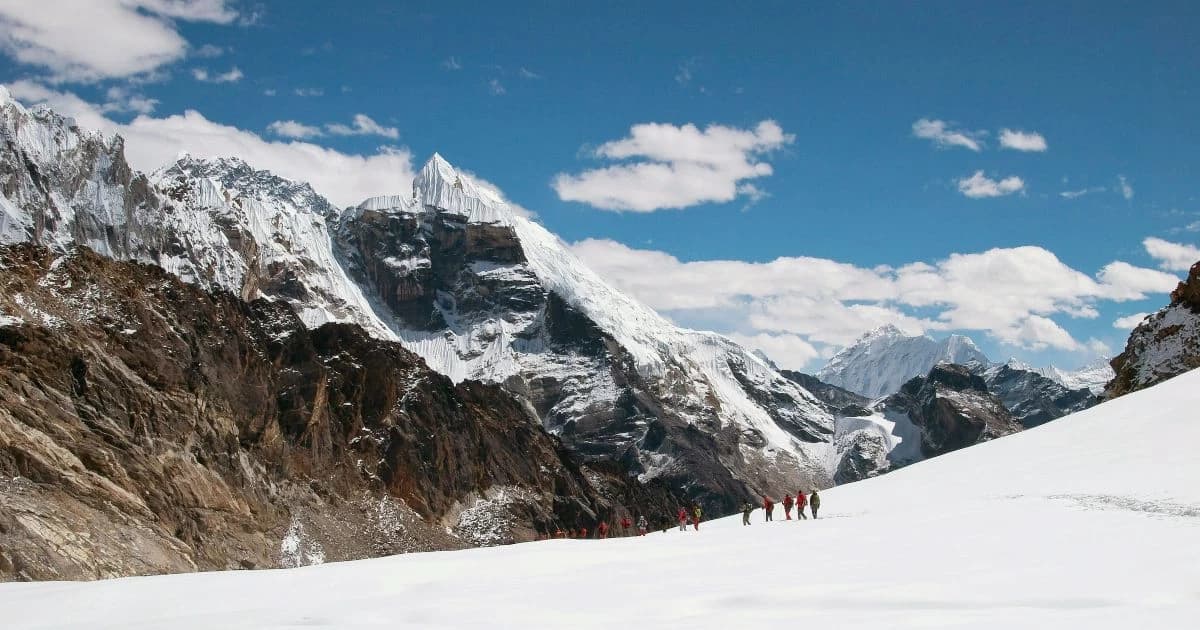
.webp&w=1200&q=75&dpl=dpl_5no2mbdoNHZofbQzNp4xwNy1a21g)
